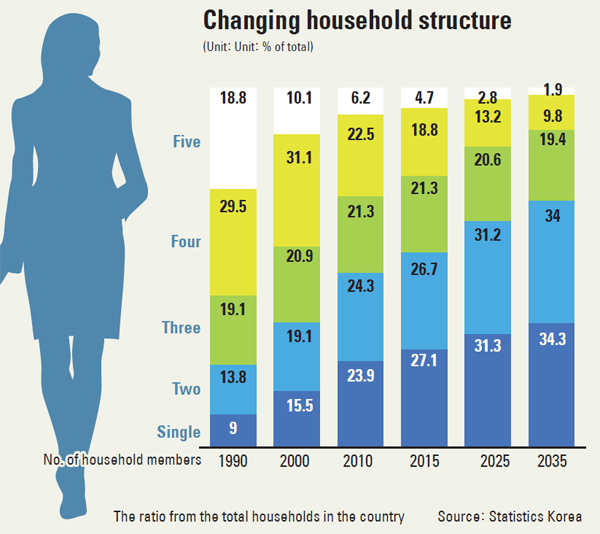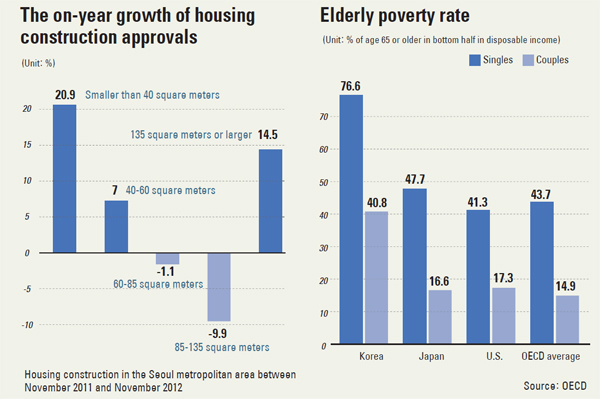Trend is to single, older households

According to the report released yesterday, the number of single households, especially the elderly, is expected to grow significantly.
While families of four accounted for nearly 30 percent of households in 1990, they now make up 22.5 percent and are estimated to account for less than 10 percent in 2025.
Conversely, the number of single-person households has grown from 9 percent in 1990 to 23.9 percent in 2010, a trend partly attributed to changing lifestyles.
Unlike in the past, when young people landed jobs, married and started families by the time they were 30, educated high-income young people tend to stay single well into their 30s and 40s.
Of the roughly 4.5 million single-member households in the country, 130,000 had annual incomes in excess of 40 million won ($36,900). Of those, more than 80 percent were in their 30s and 50s.
Another contributing factor to the increase in single households is a rising divorce rate.
Those who live alone after divorce amounted to 630,000 households last year, nearly 14 percent of single households. This figure is expected to more than double to 1.3 million by 2035.
The trend toward smaller households is reflected in housing preferences.
Compared to a year ago, government approval for the construction of apartments that are 85 square meters (915 square feet) or less has risen more than 10 percent while the share of houses larger than 85 square meters significantly dropped.
This is a stark contrast to the mid-2000s when the real estate market was soaring.
“As the number of single-member households increases at an alarming rate, related industries such as housing, food and electronic goods are changing accordingly,” said Seo Jung-ju, KB Financial Group’s research center analyst. “However, the government and the financial industry are relatively behind such changes.”
Seo noted that housing-related financial products are focused more on the traditional family structure of four or more members. The report recommends more financial products targeting people living alone.
Seo said single people in their 20s and 30s are less inclined to own housing, as they prefer rent.
Therefore, instead of focusing on mortgages for these customers, it is better to offer other financial products such as savings or pensions, as they need to manage their assets in ways other than investing in real estate.

But the biggest change and the one the financial industry should take notice of is the increasing number of elderly single households in poverty.
Korea has a rapidly aging society. Eighteen years from now, those aged 65 years or more are expected to represent at least 20 percent of the population, and by 2045 Korea is expected to have the oldest population in the world, with the average age of 50.
Although the population is aging fast, 20 percent of single family households aren’t financially prepared for retirement, while 27 percent have no plans at all.
And most single elders have their assets tied up in real estate.
This could become a problem once their living expenses, including medical costs, go up.
“Elders are in need of reorganizing their real-estate dependent assets to other financial products,” said Seo of the KB Financial Group research center.
Medical costs for elders, which accounted for 22.9 percent of the country’s health-care spending in 2004, were 32.2 percent in 2011.
The report also said it is more urgent to create a system that would either help elders in poverty to either maintain their assets or manage them effectively.
Among those aged 55 to 79, 45 percent receive pensions of less than 100,000 won a month.
Korea has the highest elderly poverty rate of the 34 Organization for Economic Cooperation and Development member countries.
Nearly half (45.1 percent) of Koreans 65 years or more have an income of less than half the national average. Ireland is next at 31.6 percent.
Of all single households, 41 percent are single elders in poverty.
By Lee Ho-jeong [ojlee82@joongang.co.kr]










with the Korea JoongAng Daily
To write comments, please log in to one of the accounts.
Standards Board Policy (0/250자)